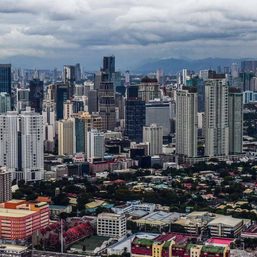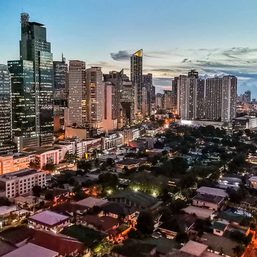SUMMARY
This is AI generated summarization, which may have errors. For context, always refer to the full article.
![[ANALYSIS] PH economy ‘on the mend’? It’s actually stalling](https://www.rappler.com/tachyon/2021/05/ph-economy-stalling.jpg)
We should be bouncing back by now. But we’re not.
On May 11, the government announced that our economy’s output, as measured by gross domestic product (GDP), shrank by 4.2% from the first quarter of 2020 to 2021.
This is disheartening for a number of reasons.
First, this tells us that we’re in the 5th straight quarter of economic decline, the longest recession we’ve had since Martial Law (during which we endured 9 consecutive quarters of decline).
Second, analysts didn’t expect the 1st quarter figures to be this bad. The median growth forecast of analysts polled by BusinessWorld was -2.6%.
Third, we’re still lagging behind our ASEAN neighbors – at least those with data (Figure 1). Vietnam grew by a stellar 4.5% last quarter, but that’s a natural consequence of their equally stellar pandemic response. (READ: Had Duterte acted earlier, PH economy would be safe to open by now)
<iframe title=”PH economy still lagging behind ASEAN neighbors” aria-label=”Interactive line chart” id=”datawrapper-chart-kM7SE” src=”https://datawrapper.dwcdn.net/kM7SE/26/” scrolling=”no” frameborder=”0″ style=”width: 0; min-width: 100% !important; border: none;” height=”500″></iframe><script type=”text/javascript”>!function(){“use strict”;window.addEventListener(“message”,(function(a){if(void 0!==a.data[“datawrapper-height”])for(var e in a.data[“datawrapper-height”]){var t=document.getElementById(“datawrapper-chart-“+e)||document.querySelector(“iframe[src*='”+e+”‘]”);t&&(t.style.height=a.data[“datawrapper-height”][e]+”px”)}}))}();</script> Figure 1
Socioeconomic Planning Secretary Karl Chua said that although the Philippine economy shrank last quarter, it’s shrinking less and less. Even so, we could be doing a lot better.
Why has the Philippine economy stalled? How can we pull ourselves out of this economic ditch?
W-shaped recession
Secretary Chua opened his GDP report by declaring that “the economy improved in the first quarter of 2021.”
But in fact the economy worsened, whether you compare it with the same quarter last year (a 4.2% drop) or the previous quarter (a 12% drop).
Maybe he was referring to the GDP data without the seasonal ups and downs of production, in which case GDP did grow by a tiny 0.3% from the previous quarter.
But even that is further proof that the economy has stalled (Figure 2). Although output rebounded a bit after the 2nd quarter of 2020 (when we had the 1st round of enhanced community quarantine), output has plateaued of late.
Put simply, we’ve failed to sustain any recovery we had last year, and we’re veering away from (rather than approaching) the economy’s long-run trajectory.
Worse, in all likelihood, we’ll see output collapsing again in the 2nd quarter of this year, owing to the new round of strict quarantine modes from late March to mid-May. We seem to be tracing out a W-shaped recession.
<iframe title=”Total output has stalled” aria-label=”Interactive line chart” id=”datawrapper-chart-iia41″ src=”https://datawrapper.dwcdn.net/iia41/5/” scrolling=”no” frameborder=”0″ style=”width: 0; min-width: 100% !important; border: none;” height=”400″></iframe><script type=”text/javascript”>!function(){“use strict”;window.addEventListener(“message”,(function(a){if(void 0!==a.data[“datawrapper-height”])for(var e in a.data[“datawrapper-height”]){var t=document.getElementById(“datawrapper-chart-“+e)||document.querySelector(“iframe[src*='”+e+”‘]”);t&&(t.style.height=a.data[“datawrapper-height”][e]+”px”)}}))}();</script>
Figure 2
Build, Build, Build is overhyped
Why has the economy stalled?
Of the main sectors that contributed to total output, those that lost steam most visibly were industry and services (Figure 3). But agriculture isn’t doing too well either, owing to a dire pork shortage accompanied by shrinking poultry production.
<iframe title=”All sectors stalled, especially industry, services” aria-label=”Interactive line chart” id=”datawrapper-chart-u6a8F” src=”https://datawrapper.dwcdn.net/u6a8F/3/” scrolling=”no” frameborder=”0″ style=”width: 0; min-width: 100% !important; border: none;” height=”400″></iframe><script type=”text/javascript”>!function(){“use strict”;window.addEventListener(“message”,(function(a){if(void 0!==a.data[“datawrapper-height”])for(var e in a.data[“datawrapper-height”]){var t=document.getElementById(“datawrapper-chart-“+e)||document.querySelector(“iframe[src*='”+e+”‘]”);t&&(t.style.height=a.data[“datawrapper-height”][e]+”px”)}}))}();</script>
Figure 3
Meanwhile, household spending on transportation, restaurants, hotels, and recreation continued to drop – as one might expect. But investment spending dropped even more, particularly on construction.
Secretary Chua was careful to distinguish between public and private construction, boasting a sizable 26.2% growth in public works. A few weeks ago, Finance Secretary Carlos Dominguez III trumpeted in a forum that Build, Build, Build will be the “main driver of rebuilding our domestic economy.”
Impressive though a 26.2% jump may seem, in truth this just amounted to a P31.3 billion increase. This is peanuts compared to the trillions of pesos originally planned for Build, Build, Build. Figure 4 also shows that the slight uptick in government construction spending (seasonally adjusted) failed to offset the tremendous decline in private sector construction.
In short, Build, Build, Build is overhyped and far from the economic cure-all it’s touted to be.
<iframe title=”Uptick in gov’t infra, but construction sector shrank all in all” aria-label=”Interactive line chart” id=”datawrapper-chart-OawOY” src=”https://datawrapper.dwcdn.net/OawOY/3/” scrolling=”no” frameborder=”0″ style=”width: 0; min-width: 100% !important; border: none;” height=”400″></iframe><script type=”text/javascript”>!function(){“use strict”;window.addEventListener(“message”,(function(a){if(void 0!==a.data[“datawrapper-height”])for(var e in a.data[“datawrapper-height”]){var t=document.getElementById(“datawrapper-chart-“+e)||document.querySelector(“iframe[src*='”+e+”‘]”);t&&(t.style.height=a.data[“datawrapper-height”][e]+”px”)}}))}();</script>
Figure 4
Plummeting remittances
With more than half a million overseas Filipino workers repatriated since the pandemic started, and millions more waiting to come home or barely clinging to their jobs, it’s no wonder that their remittances have shrunk.
This can be gleaned not just from actual remittance data from the Bangko Sentral ng Pilipinas, but also in the national income data – specifically in the decline of net primary income or NPI (Figure 5). We’re down to levels not seen since before 2000.
Remittances are crucial since they fuel household consumption spending. But they’re also a major source of foreign exchange. The plummeting of remittances – if it goes on for much longer – might make it harder for the country to pay for its imports or external debts in the future.
<iframe title=”Remittances have nosedived” aria-label=”Interactive line chart” id=”datawrapper-chart-fZPWf” src=”https://datawrapper.dwcdn.net/fZPWf/1/” scrolling=”no” frameborder=”0″ style=”width: 0; min-width: 100% !important; border: none;” height=”400″></iframe><script type=”text/javascript”>!function(){“use strict”;window.addEventListener(“message”,(function(a){if(void 0!==a.data[“datawrapper-height”])for(var e in a.data[“datawrapper-height”]){var t=document.getElementById(“datawrapper-chart-“+e)||document.querySelector(“iframe[src*='”+e+”‘]”);t&&(t.style.height=a.data[“datawrapper-height”][e]+”px”)}}))}();</script>
Figure 5
What can government do?
The recession is dragging on needlessly. Is there anything government can do to end it soonest?
First, government ought to pour its energies and resources on the pandemic response – as we’ve been saying for months.
Secretary Chua said that “managing risks and safely reopening the economy are the most effective ways to address hunger and poverty brought about by the pandemic.”
They should be pushing instead for the elimination (rather than mere mitigation) of COVID-19, similar to what other countries like Australia and New Zealand have done. That’s the only way to ensure robust economic recovery.
But this is not the government’s strategy. Even as new cases are still numbering 4,000 to 7,000 daily, and even as new variants such as the one from India have been detected in the country, President Rodrigo Duterte again decided to loosen the quarantine restrictions in Metro Manila starting May 15. It feels like another time bomb is just waiting to explode. If it does, it will certainly impale the economy yet again.
Second, government must accelerate its vaccination program. Close to 8 million doses have been delivered to the country, but only half of 1% of Filipinos have received both doses. At this rate, the government’s goal of fully inoculating 70% of the population might take decades.
Even as vaccines become more and more available, we shouldn’t let our guard down. Mass vaccination is no guarantee of herd immunity, as Chile and Seychelles have recently shown. (Incidentally, both these countries relied heavily on China-made vaccines.)
Third, the Duterte government needs to ramp up spending, especially on economic aid. But Duterte’s economic managers, hopelessly wedded to a misguided notion of “fiscal prudence,” continue to thumb down Bayanihan 3, an economic relief package in excess of P400 billion that could save millions of lives and livelihoods.
Secretary Chua said they “would just be throwing money to [affected] sectors where in fact there is no demand, because…the economy is not fully open.” But we want to give money to people in these sectors precisely because there’s little to no demand and the economy can’t yet be fully reopened.
Secretary Chua also said that the 2021 budget was “designed to address [the] problems” caused by the pandemic. But that’s an outright lie. (READ: Why you should be alarmed by Duterte’s 2021 budget)
While the economic managers have stubbornly refused aid to the poor, they’ve generously aided the rich. (READ: Amid record hunger, Duterte aids the rich)
Desperate cover-up
Secretary Chua ended his GDP report by saying that the economy is “on the mend” partly because of “the country’s strong position before the pandemic.”
But that’s like saying a person hit by a truck is now on the mend because he was perfectly healthy before the accident. Stop living in the past!
Despite the grim outlook, the economic managers are also clinging to their lofty growth targets. Secretary Chua still said that “our actions in the next 8 months can reverse [the] initial losses.”
This year, they’re eyeing a GDP growth of at least 6.5% and at most 7.5%. But to even reach 6.5%, we will need a whopping 10% growth rate in each of the next 3 quarters. That’s reaching for the moon. The 2nd quarter data will almost certainly be in the red, too.
It sounds like the economic managers are desperately covering up the stinking pile of garbage that is their abysmal handling of the economy. But there’s only so much they can do. Eventually the stink will come through. – Rappler.com
JC Punongbayan is a PhD candidate and teaching fellow at the UP School of Economics. His views are independent of the views of his affiliations. Follow JC on Twitter (@jcpunongbayan) and Usapang Econ (usapangecon.com).
Add a comment
How does this make you feel?
![[Vantage Point] Joey Salceda says 8% GDP growth attainable](https://www.rappler.com/tachyon/2024/04/tl-salceda-gdp-growth-04192024.jpg?resize=257%2C257&crop_strategy=attention)
![[In This Economy] Looks like PH economy will never get back on track. Here’s the data.](https://www.rappler.com/tachyon/2024/02/20240202-PH-economy-back-on-track.jpg?resize=257%2C257&crop=289px%2C0px%2C720px%2C720px)

![[In This Economy] Something’s broken, and it’s hidden by ‘high’ economic growth](https://www.rappler.com/tachyon/2023/11/something-broken-hidden-economic-growth-November-10-2023.jpg?resize=257%2C257&crop=276px%2C0px%2C720px%2C720px)

There are no comments yet. Add your comment to start the conversation.